CADILLAC XLR V 2007 1.G Owners Manual
Manufacturer: CADILLAC, Model Year: 2007, Model line: XLR V, Model: CADILLAC XLR V 2007 1.GPages: 512, PDF Size: 3.84 MB
Page 141 of 512
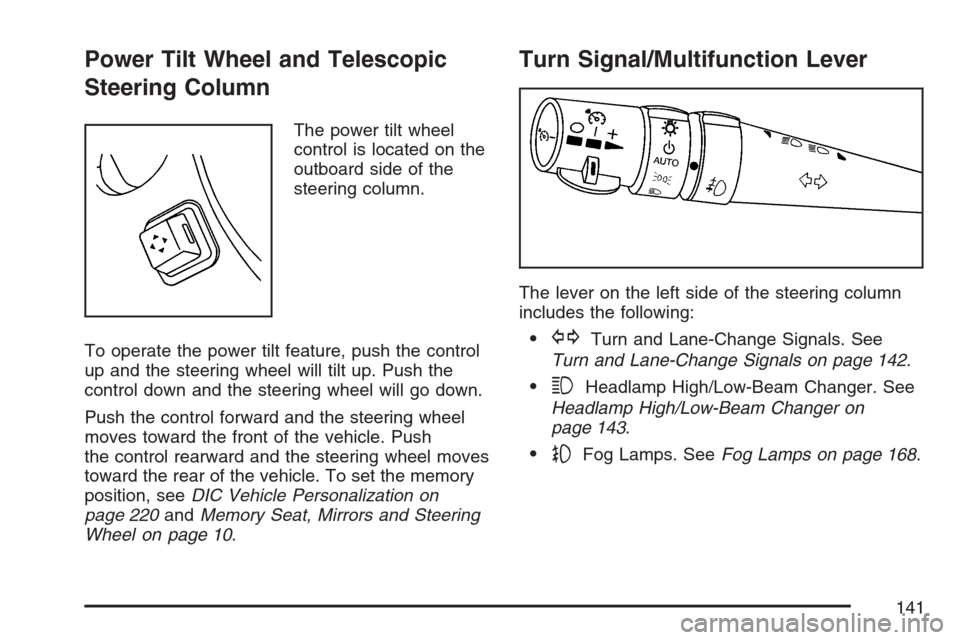
Power Tilt Wheel and Telescopic
Steering Column
The power tilt wheel
control is located on the
outboard side of the
steering column.
To operate the power tilt feature, push the control
up and the steering wheel will tilt up. Push the
control down and the steering wheel will go down.
Push the control forward and the steering wheel
moves toward the front of the vehicle. Push
the control rearward and the steering wheel moves
toward the rear of the vehicle. To set the memory
position, seeDIC Vehicle Personalization on
page 220andMemory Seat, Mirrors and Steering
Wheel on page 10.
Turn Signal/Multifunction Lever
The lever on the left side of the steering column
includes the following:
GTurn and Lane-Change Signals. See
Turn and Lane-Change Signals on page 142.
3Headlamp High/Low-Beam Changer. See
Headlamp High/Low-Beam Changer on
page 143.
-Fog Lamps. SeeFog Lamps on page 168.
141
Page 142 of 512
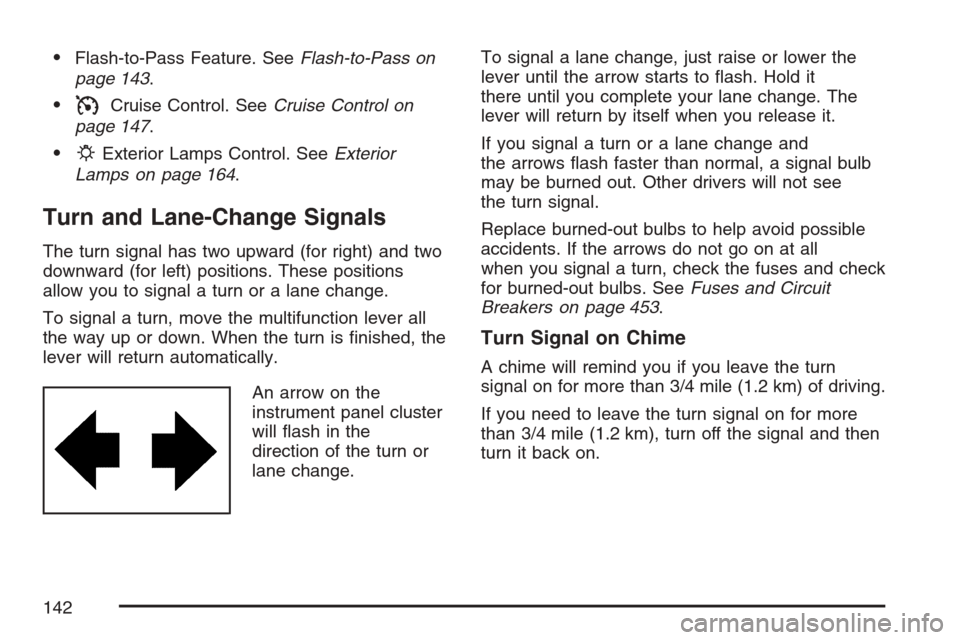
Flash-to-Pass Feature. SeeFlash-to-Pass on
page 143.
ICruise Control. SeeCruise Control on
page 147.
PExterior Lamps Control. SeeExterior
Lamps on page 164.
Turn and Lane-Change Signals
The turn signal has two upward (for right) and two
downward (for left) positions. These positions
allow you to signal a turn or a lane change.
To signal a turn, move the multifunction lever all
the way up or down. When the turn is �nished, the
lever will return automatically.
An arrow on the
instrument panel cluster
will �ash in the
direction of the turn or
lane change.To signal a lane change, just raise or lower the
lever until the arrow starts to �ash. Hold it
there until you complete your lane change. The
lever will return by itself when you release it.
If you signal a turn or a lane change and
the arrows �ash faster than normal, a signal bulb
may be burned out. Other drivers will not see
the turn signal.
Replace burned-out bulbs to help avoid possible
accidents. If the arrows do not go on at all
when you signal a turn, check the fuses and check
for burned-out bulbs. SeeFuses and Circuit
Breakers on page 453.
Turn Signal on Chime
A chime will remind you if you leave the turn
signal on for more than 3/4 mile (1.2 km) of driving.
If you need to leave the turn signal on for more
than 3/4 mile (1.2 km), turn off the signal and then
turn it back on.
142
Page 143 of 512
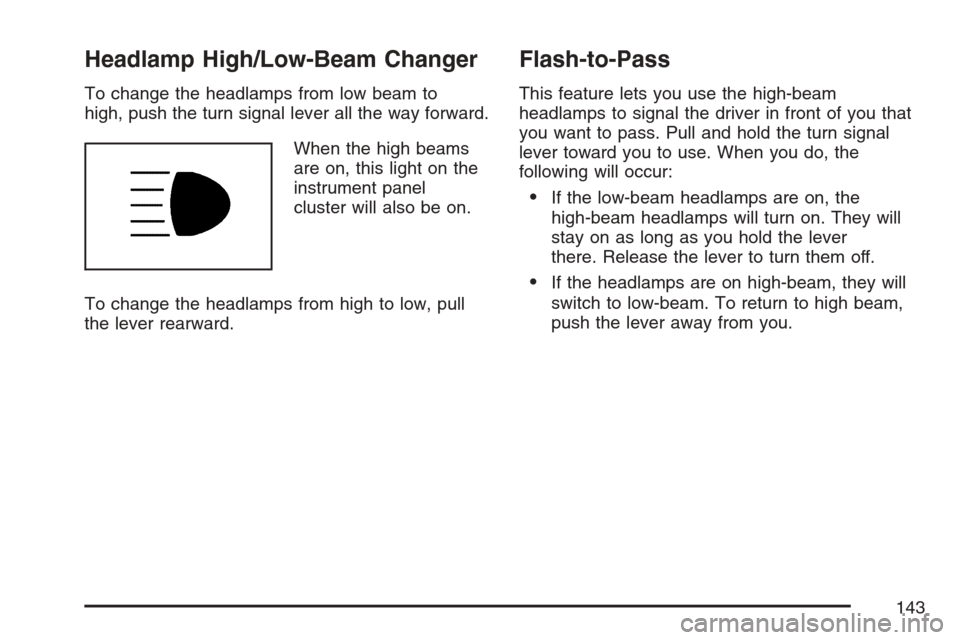
Headlamp High/Low-Beam Changer
To change the headlamps from low beam to
high, push the turn signal lever all the way forward.
When the high beams
are on, this light on the
instrument panel
cluster will also be on.
To change the headlamps from high to low, pull
the lever rearward.
Flash-to-Pass
This feature lets you use the high-beam
headlamps to signal the driver in front of you that
you want to pass. Pull and hold the turn signal
lever toward you to use. When you do, the
following will occur:
If the low-beam headlamps are on, the
high-beam headlamps will turn on. They will
stay on as long as you hold the lever
there. Release the lever to turn them off.
If the headlamps are on high-beam, they will
switch to low-beam. To return to high beam,
push the lever away from you.
143
Page 144 of 512
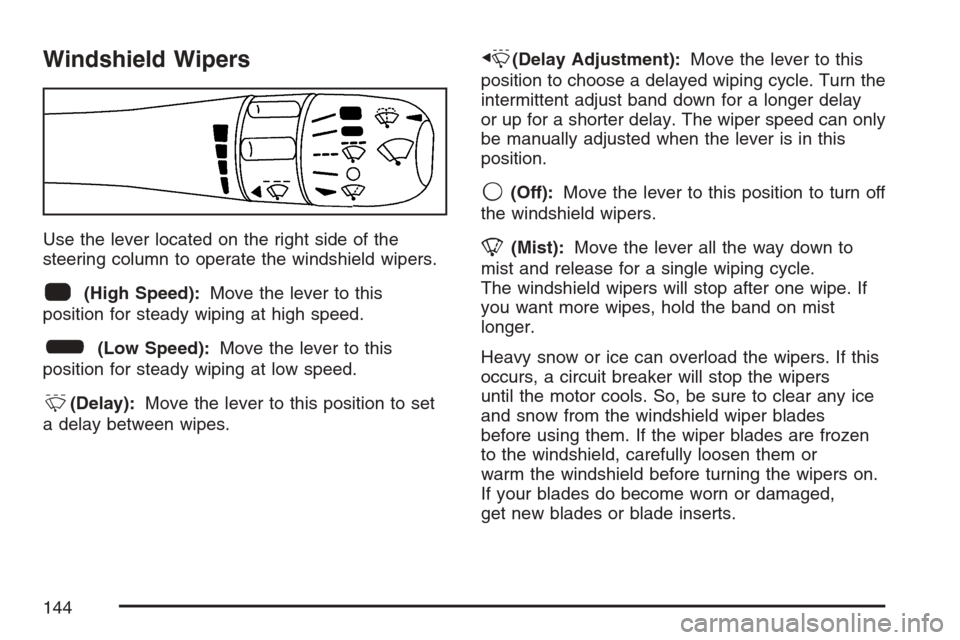
Windshield Wipers
Use the lever located on the right side of the
steering column to operate the windshield wipers.
1(High Speed):Move the lever to this
position for steady wiping at high speed.
6(Low Speed):Move the lever to this
position for steady wiping at low speed.
&(Delay):Move the lever to this position to set
a delay between wipes.
x(Delay Adjustment):Move the lever to this
position to choose a delayed wiping cycle. Turn the
intermittent adjust band down for a longer delay
or up for a shorter delay. The wiper speed can only
be manually adjusted when the lever is in this
position.
9(Off):Move the lever to this position to turn off
the windshield wipers.
8(Mist):Move the lever all the way down to
mist and release for a single wiping cycle.
The windshield wipers will stop after one wipe. If
you want more wipes, hold the band on mist
longer.
Heavy snow or ice can overload the wipers. If this
occurs, a circuit breaker will stop the wipers
until the motor cools. So, be sure to clear any ice
and snow from the windshield wiper blades
before using them. If the wiper blades are frozen
to the windshield, carefully loosen them or
warm the windshield before turning the wipers on.
If your blades do become worn or damaged,
get new blades or blade inserts.
144
Page 145 of 512
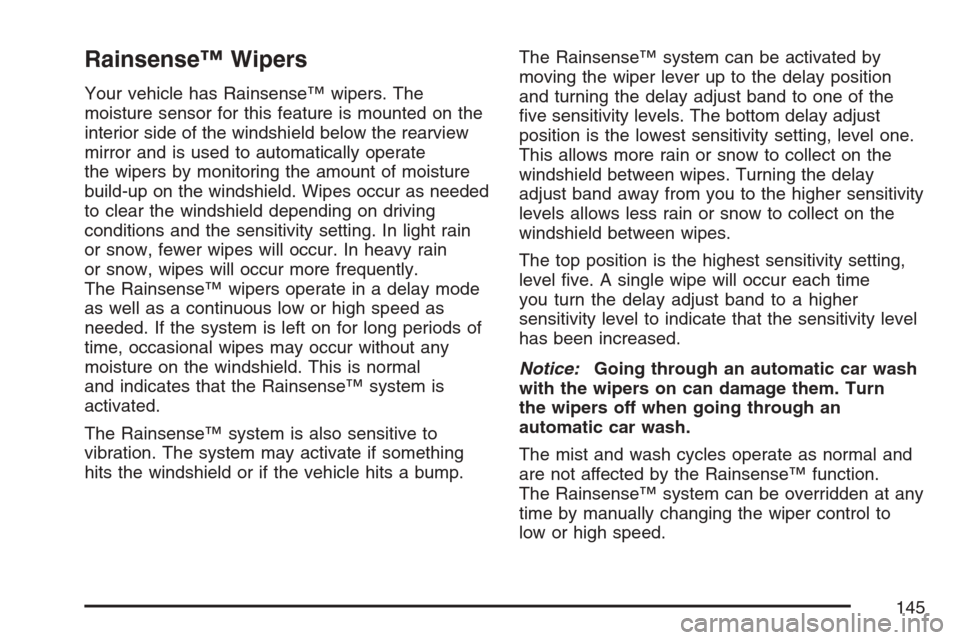
Rainsense™ Wipers
Your vehicle has Rainsense™ wipers. The
moisture sensor for this feature is mounted on the
interior side of the windshield below the rearview
mirror and is used to automatically operate
the wipers by monitoring the amount of moisture
build-up on the windshield. Wipes occur as needed
to clear the windshield depending on driving
conditions and the sensitivity setting. In light rain
or snow, fewer wipes will occur. In heavy rain
or snow, wipes will occur more frequently.
The Rainsense™ wipers operate in a delay mode
as well as a continuous low or high speed as
needed. If the system is left on for long periods of
time, occasional wipes may occur without any
moisture on the windshield. This is normal
and indicates that the Rainsense™ system is
activated.
The Rainsense™ system is also sensitive to
vibration. The system may activate if something
hits the windshield or if the vehicle hits a bump.The Rainsense™ system can be activated by
moving the wiper lever up to the delay position
and turning the delay adjust band to one of the
�ve sensitivity levels. The bottom delay adjust
position is the lowest sensitivity setting, level one.
This allows more rain or snow to collect on the
windshield between wipes. Turning the delay
adjust band away from you to the higher sensitivity
levels allows less rain or snow to collect on the
windshield between wipes.
The top position is the highest sensitivity setting,
level �ve. A single wipe will occur each time
you turn the delay adjust band to a higher
sensitivity level to indicate that the sensitivity level
has been increased.
Notice:Going through an automatic car wash
with the wipers on can damage them. Turn
the wipers off when going through an
automatic car wash.
The mist and wash cycles operate as normal and
are not affected by the Rainsense™ function.
The Rainsense™ system can be overridden at any
time by manually changing the wiper control to
low or high speed.
145
Page 146 of 512
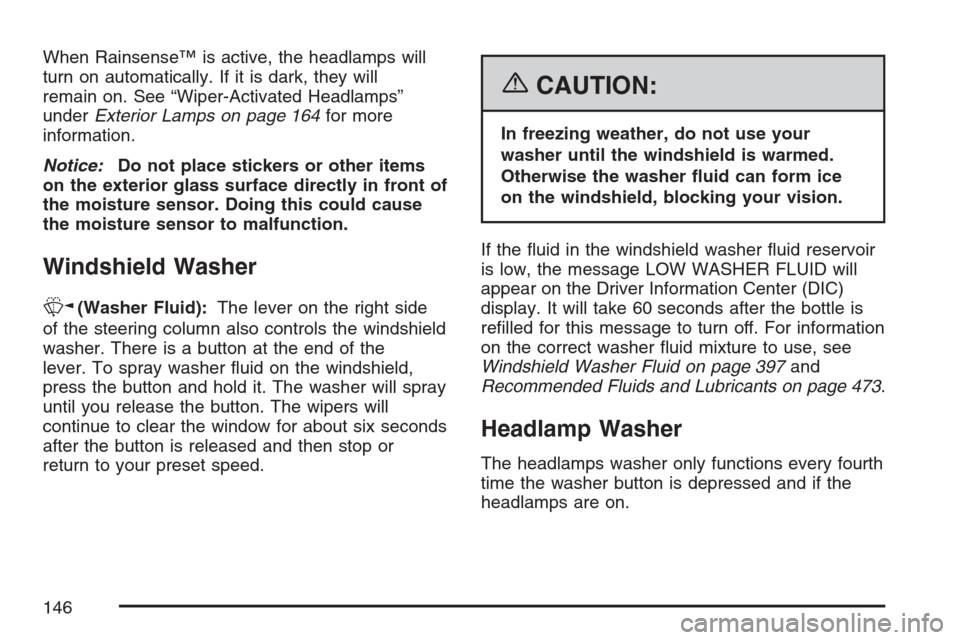
When Rainsense™ is active, the headlamps will
turn on automatically. If it is dark, they will
remain on. See “Wiper-Activated Headlamps”
underExterior Lamps on page 164for more
information.
Notice:Do not place stickers or other items
on the exterior glass surface directly in front of
the moisture sensor. Doing this could cause
the moisture sensor to malfunction.
Windshield Washer
K(Washer Fluid):The lever on the right side
of the steering column also controls the windshield
washer. There is a button at the end of the
lever. To spray washer �uid on the windshield,
press the button and hold it. The washer will spray
until you release the button. The wipers will
continue to clear the window for about six seconds
after the button is released and then stop or
return to your preset speed.
{CAUTION:
In freezing weather, do not use your
washer until the windshield is warmed.
Otherwise the washer �uid can form ice
on the windshield, blocking your vision.
If the �uid in the windshield washer �uid reservoir
is low, the message LOW WASHER FLUID will
appear on the Driver Information Center (DIC)
display. It will take 60 seconds after the bottle is
re�lled for this message to turn off. For information
on the correct washer �uid mixture to use, see
Windshield Washer Fluid on page 397and
Recommended Fluids and Lubricants on page 473.
Headlamp Washer
The headlamps washer only functions every fourth
time the washer button is depressed and if the
headlamps are on.
146
Page 147 of 512

Cruise Control
Your vehicle has cruise control.
9(Off):This position
turns the system off.
R(On):This position turns the system on.
+ (Resume/Accelerate):This position makes the
vehicle accelerate or resume to a previously
set speed.
T(Set):Press this button at the end of the
lever to set the speed.
With cruise control, you can maintain a speed of
about 25 mph (40 km/h) or more without
keeping your foot on the accelerator. This can
really help on long trips. Cruise control does not
work at speeds below about 25 mph (40 km/h).Cruise control will not work if the parking brake is
set, or if the master cylinder brake �uid level is low.
{CAUTION:
Cruise control can be dangerous where
you cannot drive safely at a steady speed.
So, do not use your cruise control on
winding roads or in heavy traffic.
Cruise control can be dangerous on
slippery roads. On such roads, fast
changes in tire traction can cause
excessive wheel slip, and you could lose
control. Do not use cruise control on
slippery roads.
If your vehicle has the traction control system and
it begins to limit wheel spin while cruise control
is on, the cruise control will automatically
disengage. SeeTraction Control System (TCS) on
page 329. When road conditions allow you to
safely use it again, you may turn cruise control
back on.
147
Page 148 of 512

Setting Cruise Control
{CAUTION:
If you leave your cruise control on when
you are not using cruise, you might hit a
button and go into cruise when you do
not want to. You could be startled and
even lose control. Keep the cruise control
switch off until you want to use cruise
control.
1. Move the cruise control switch to on.
2. Get up to the speed desired.
3. Press the set button at the end of the lever
and release it.
4. Take your foot off the accelerator pedal.The cruise symbol on
the instrument panel
cluster will be lit
when the cruise control
is engaged.
Resuming a Set Speed
Suppose you set your cruise control at a desired
speed and then you apply the brake. This
disengages the cruise control. But it does not
need to be reset.
Once you are going about 25 mph (40 km/h) or
more, you can move the cruise control switch
brie�y from on to resume/accelerate.
You will go right back up to your chosen speed
and stay there.
If you hold the switch at resume/accelerate the
vehicle will keep going faster until you release the
switch or apply the brake. Do not hold the
switch at resume/accelerate, unless you want the
vehicle to go faster.
148
Page 149 of 512

Increasing Speed While Using Cruise
Control
There are two ways to go to a higher speed:
Use the accelerator pedal to get to the higher
speed. Press the set button at the end of the
lever, then release the button and the
accelerator pedal. You will now cruise at the
higher speed. If the accelerator pedal is
held longer than 60 seconds, cruise control
will turn off.
Move the cruise switch from on to resume/
accelerate. Hold it there until you get up to the
desired speed, and then release the switch. To
increase your speed in very small amounts,
move the switch brie�y to resume/accelerate.
Each time you do this, your vehicle will go
about 1 mph (1.6 km/h) faster.
Reducing Speed While Using Cruise
Control
Press and hold the set button until you reach
the lower speed desired, then release it.
To slow down in very small amounts, brie�y
press the set button. Each time you do this,
your vehicle will go about 1 mph (1.6 km/h)
slower.
Passing Another Vehicle While Using
Cruise Control
Use the accelerator pedal to increase your speed.
When you take your foot off the pedal, your
vehicle will slow down to the cruise control speed
you set earlier.
149
Page 150 of 512

Using Cruise Control on Hills
How well your cruise control works on hills
depends upon your speed, load and the steepness
of the hills. When going up steep hills, you
might have to step on the accelerator pedal to
maintain your speed. When going downhill,
you might have to brake or shift to a lower gear to
keep your vehicle’s speed down. Of course,
applying the brake turns off the cruise control.
Many drivers �nd this to be too much trouble and
do not use cruise control on steep hills.
Ending Cruise Control
There are two ways to turn off the cruise control:
Step lightly on the brake pedal
Move the cruise control switch to off
Erasing Speed Memory
Turning off the cruise control or the ignition, will
erase your cruise control set speed memory.
Adaptive Cruise Control
If your vehicle has this feature, be sure to read
this entire section before using it.
The system operates on a radio frequency subject
to Federal Communications Commission (FCC)
Rules and with Industry Canada.
This device complies with Part 15 of the FCC
Rules. Operation is subject to the following
two conditions:
1. This device may not cause interference.
2. This device must accept any interference
received, including interference that may
cause undesired operation of the device.
This device complies with RSS-210 of Industry
Canada. Operation is subject to the following two
conditions:
1. This device may not cause interference.
2. This device must accept any interference
received, including interference that may
cause undesired operation of the device.
Changes or modi�cations to this system by other
than an authorized service facility could void
authorization to use this equipment.
150